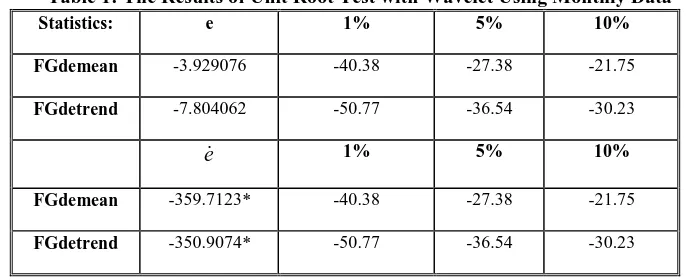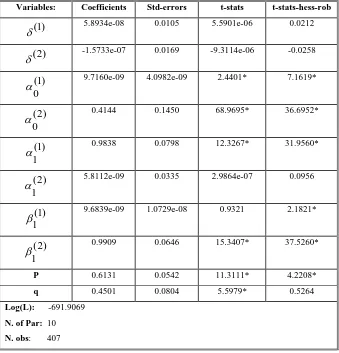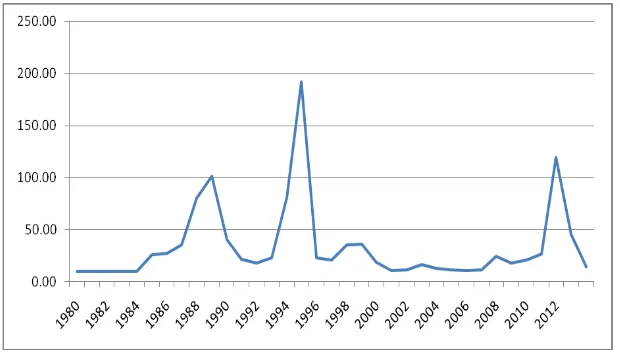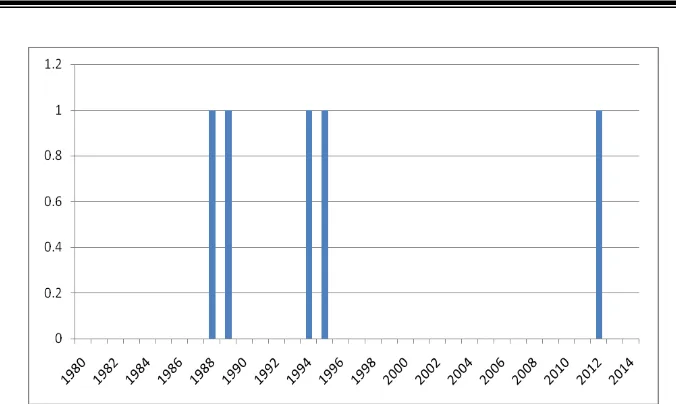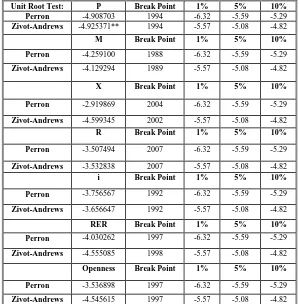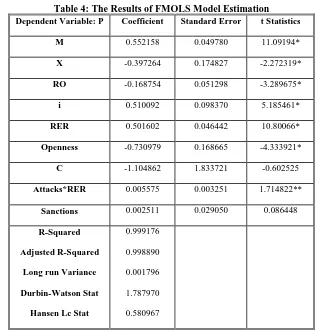The Effects of Economic Sanctions and Speculative
Attacks on Inflation
Farshid Pourshahabi Nazar Dahmardeh
Received: 2014/07/13 Accepted: 2014/12/19
Abstract
his paper surveys the persian monetary crises due to economic sanctions and speculative attacks that leads to high inflation. Economic sanctions are associated with various forms of trade barriers and restriction on financial transactions. Among the most influential sanctions on Iran's oil export and central bank sanctions are noted that their Aims to reduce Iran's oil revenues and Devaluation of the national currency of Iran. New economic sanctions have greatest effect on foreign currency transactions and foreign currency speculative attacks can lead to devaluation of the national currency to be stimulated inflationary pressures. This study introduced a new inflation function based on Neo-Keynesian framework in the case of oil exporting counties. Also dynamics of speculative attacks based on Markov Regime-Switching GARCH (MRS-GARCH) model is used to capture some of the exchange rate dynamics associated with the speculative attacks. The results of co-integration vector estimation using the FMOLS approach indicated that speculative attacks have positive effect on inflation but sanctions affect inflation indirectly through speculative attacks, stagnation, currency crisis, expected inflation and etc.
Keywords: Economic Sanctions, Speculative Attacks, inflation.
1-
Introduction
Economic sanctions are penalties include various form of trade barriers and restrictions on financial transactions. They may be imposed for a variety of political and social issues that can be used for achieving domestic political
Assistant Professor in Economics, University of Bojnord, Bojnord, Iran (Corresponding Author)
Associate Professor in Economics, University of Sistan Baluchestan, Zahedan, Iran.
T
gain. Following the Iranian Revolution in 1979, the United States imposed sanctions against Iran and expanded them in 1995 and also UN Security Council passed a number of resolutions imposing sanctions on Iran, when Iran rejected the Security Council's demand that Iran suspend all enrichment-related and reprocessing activities in 2006. Sanctions targeted investment in Oil, gas and petrochemical, refined petroleum products export, business dealing with the Iranian republican guard corps, encompasses banking and insurance transactions including central bank of Iran and Iranian banks blacklisted by the EU were disconnected from the Society for Worldwide Interbank Financial Telecommunication (SWIFT) banking network, shipping, web hosting and domain name registration services.
The effect of sanctions on Iranian economy based on Congressional Research Service report in May 2014 is including: 1- decline in oil export about 60% from 2.5 mbd in 2011 to 1 mbd in 2013 that this leads to reduce in Iran’s oil sale revenue from $100 billion to $35 billion. The International Energy Agency (IEA) report in April 2014 shows that Iran’s oil exported about 1.65 mbd in February 2014. 2- Oil Production is decreased from 4.0 mbd at end of 2011 to about 2.6-2.8 mbd. 3- Iran has not been paid in hard currency for its oil export revenue nearly $100 billion and Iran was unable to access as much as $60-$80 billions duo to banking restrictions. 4- Iran suffers gross domestic product (GDP) contraction and it dropped about 5%. Also unemployment rate was increased about 20%. 5- Value of Rial on unofficial markets declined from about 13000 of the US dollar in September 2011 to about 37000 to the US dollar in May 2013 and to about 29000 to the US dollar as of start 2014. 6- Value of Rial Declining caused inflation acceleration. Central bank of Iran reported 45% rate in July 2013 and many economist asserted 50% and 70% rate. 7-Currency declination and finance restriction have made Iran’s manufacturing sector difficult to operate, for example Iran’s automobile sector fell down about 40% from 2011 to 2013.
(1975) at the Federal Reserve Board. Krugman (1979) adapted their mechanism to explain speculative attacks in the foreign exchange market. Financial speculative attack research typically grouped into three categories: first generation models argue that sudden speculative attack on a fixed exchange rate is a result of rational behavior by investor even though it appears to be an irrational change in expectation. Second generation models argue that doubts about government reaction to maintain its exchange rate peg led to multiple equilibriums and expect of investors about other investors to attack the currency leads to attack the currency. Third generation models explored how banking and financial system interact with currency crises and how they have real effect on the economy. Sudden devaluation of a currency or currency crises often occurs in speculative attack in foreign exchange market and usually affects fixed exchange rate regimes rather than floating regimes.
Therefore, economic sanctions and speculative attack lead to promote foreign exchange rate. Increasing in exchange rate has direct and indirect effects on inflation. Directly, increasing of exchange rate are associated with increasing of the imported goods and services price including final, intermediate and capital goods and services and they will contribute to increase in inflation. Indirectly, domestic currency depreciation become relatively cheaper domestic product for foreigner and demand for export will increase that associated with increase in demand for domestic good and services and inflationary pressure. Inflation is a sustained increasing in the aggregate price level and if price increasing are extremely rapid or out of control then concept of inflation meaningless and this situation is high inflation. Thus, this study examines the effect of economic sanctions and speculative attack on high inflation in Iranian economy based on Neo-Keynesian framework in the case of oil exporting counties. MRS-GARCH model is used to capture some of the exchange rate dynamics associated with the speculative attack and FMOLS approach is used for estimation purpose.
2-
Literature Review
effective when are imposed against relatively small target countries; relatively sane foreign policy goals; weak economy and unstable politic of target country; quickly and decisively sanctions; sanctioning country avoids high costs to itself; more trade linkage among sender and target countries and ability of sender and target countries to conduct substantial trade. Elliott and Uimonen (1993) based on Lam (1990) analysis introduced economic sanctions as an alternative to war. This study supported Hufbauer and et al (1990) for Iraq that sanctions work best when the goal is modest, there is extensive trade linkage and weak economy, extend of cooperation among nations in imposing the sanctions and unstable politic of target country. Their model indicated that probabilities of success in the Iraq case were above 50 percent.
Currency crisis are painful events and they are often associated with negative real growth, high level of inflation, sever trade, budget deficit and etc. therefore, poor economic development expected due to currency crisis and it depend in a fundamental way on the central banks crisis management. Therefore, understanding of currency crises mechanism is important to specify the optimal policy response to an emerging crisis. Erler and et al (2014) introduced 3 types of currency crisis: 1-immediate depreciation, 2-successful defense, and 3-un2-successful defense or delayed depreciation. Once a central bank has started to intervene in foreign exchange because she is not able to intervene (e.g. reserves are depleted) or she is not willing to further intervene (e.g. expected benefits of the intervention are less than there expected costs). Central bank intervenes can permanently succeeds and achieve the best economic performance or it can only stabilize the exchange rate transitorily and ultimately fails in her intervention policy. In the case of successful defense the central bank can completely neutralize the effect of speculative attack and in unsuccessful defense associated with high costs in term of output loss.
monetary and fiscal policies, increase in inflation differentials, and appreciation of real exchange rate can be attributed to speculative pressures. Also, declining in foreign reserves and the increase in the share of foreign currency indexed debt are main factors which contributed to the timing of the crisis. Gupta et al. (2007) indicated that crisis can have very different economic outcomes and it is more sever in the case of large capital inflows during pre-crisis periods, fewer capital market restrictions, lower trade openness and higher external long term debt. Cerra and Saxena (2008) and Bussiere et al. (2010) indicated that currency crisis associated with a permanent output loss of 2-6% of GDP.
Pansard (1999) shows that the relation between the interest rate differential and the fundamentals before the speculative attack is dependent on the public expectations relative to monetary policy by the central bank after the attack. Willman (1987) investigated that if pre crisis exchange rate is constrained by set limits and there is uncertainty about monetary policy reactions, balance of payments crisis are accompanied by discrete in exchange rate. Darzen (2000) and Darzen (2003) argue that high interest rate is as a signal of the government’s willingness or ability to defend the exchange rate and it can potentially deters a speculative attack. Angeletos et al. (2006) discuss there is an inactive policy equilibrium when the fundamentals are very strong or very weak because speculators coordinate on ignoring any attempt of the government to affect market behavior. Also, when the fundamentals are neither too weak nor too strong there is a continuum of active policy equilibrium to raise the interest rate to meet the market expectation and thus avoid attacks. In this condition speculators coordinate on either an aggressive or a lenient course of action.
the risk premium in the long run. Grier and Lin (2010) investigate that rising interest rate significantly reduces the probability of attacks in hard pegging countries but increases it in soft pegging countries. They find that high reserves and capital controls enhance the effectiveness of monetary policy against speculative attacks and also the weak monetary authority faces a higher probability of attack.
Bergman and Jellingso (2010) find that interest rate defense can prevent a currency crisis in the short run but it may cause a currency crisis in the medium term. This result supported the empirical observation the interest rate defense have been successful in some studies but unsuccessful in other. Therefore policy makers must carefully evaluate the characteristics of their economy before using monetary policy. Also, they find that expectation of future capital control by raising the risk premium making the economy more vulnerable to crisis. Rochon (2006) surveyed when fundamentals are stronger and deteriorate more slowly, the informed speculators delay attacking longer. Also, high opportunity costs make speculators become informed more slowly. Bartolini and Parti (1998) suggested that soft target zones or allowing the exchange rate to move within wide margins in the short run but within narrow margins in the long run are significantly less vulnerable to speculative attack than hard target zones. The results of Disyatat (2002) indicated that countries with higher degree of financial market imperfection, weak banking sector balance sheets are much more likely to suffer a contraction in the wake of a currency crisis.
aggregate demand and putting upward pressure on domestic prices. Ghosh and Rajan (2007) investigated that exchange rate has a greater effect on import prices than national CPI because CPI includes non-tradable goods that are less responsive to exchange rate changes.
3-
Model Specification
In this study new inflation function is extracted with using Neo-Keynesian framework in the case of oil exporting countries. Notice to the importance of oil sector in economics of these countries it is necessary to include oil sector in the model analysis. Therefore we consider simple two-sector model for this reason, including oil exporting sector (O) and other sectors that it includes all sectors in the economy except oil exporting sector (X). We assume that these two sectors use labor force and capital in the production process. Therefore we have:
)
,
(
L
xK
xX
X
(1))
,
(
L
oK
oO
O
(2)We assume that these production functions are linearly homogenous and concave. Therefore:
0
L LX
(3)0
K LX
(4)0
L LO
(5)0
K LO
(6)With assume perfect competition condition in commodity and factor markets have nominal factor prices are equal to marginal value productivity. The first partial derivation of each production function is marginal product of factors,
W
i is nominal wage andR
i is nominal rent of capital. Alsop
iin these equations are product price.
L x x
p
X
W
.
(7)L
O
p
W
0
0.
(8)K x x
p
X
R
.
(9)K
O
p
Also, it assumed that labor force and capital are mobile and inelastically supplied that showed with bar atop on the variables, also we have full employment among these sectors:
L
L
L
x
0
(11)K K
Kx 0 (12)
It can expect that wage rate in O sector is more than X sector, because of more productivity, proficiency and rigidity condition of labor force in oil exporting sector. We can show the relationship between these wages with follow:
0
0
W
x
W
(13)
Notice to this subject that oil exporting countries have small economics, so level of domestic price (P) is equal to the level of price in sector X (px) plus world relative price of imported goods (pf) with β coefficient (Notice: world related price multiplied to exchange rate (ER) to transform foreign price level to domestic price level). The sign of β coefficient is related to economic conditions. If world relative price of imported goods that exogenously determined is lower that the level of price in domestic economy (because of lower productivity and efficiency in oil exporting countries rather than other countries) then we expected that β coefficient has negative sign. Also if world relative price is higher than domestic price we can expected that β coefficient sign is positive. It is obvious that the scale of foreign price effect is related to trade openness of the country; therefore β coefficient is a function of trade openness.
) . .( f x ER p
p
P
(14)
In this economy nominal gross domestic product (Y) is:
X
p
O
p
Y
0.
x.
(15)
Therefore real gross domestic product (y) investigated from Y divided to P:
X
p
ER
p
p
O
P
p
P
Y
f x
x
.
)
.
(
.
.
0
Thus: ) ( . RER p x RO y x
(17)
We know that real money demand for money is function of interest rate (i) and real gross domestic product that interest rate has negative effect on real money demand and the relationship between gross domestic product and real money demand is positive. We can write real money demand function as below:
)
,
(
i
y
M
P
M
d
(18)
From equilibrium in money market we have:
)
,
(
i
y
PM
M
(19)
In this equation
M
is supply of money and exogenously determined.From total differentiation yields:
P
dy
y
M
P
di
i
M
M
dP
M
d
.
.
.
.
.
(20)
With assume P=1 for initial value for simplifies and rearrangement we have:
(21)
y
y
dy
y
M
i
i
di
i
M
M
dP
M
d
.
.
.
.
.
andM
y
y
dy
y
M
M
i
i
di
i
M
dP
M
M
d
.
.
.
.
.
.
(22)
Therefore: y dy e i di e dP M M d My Mi. .
Where the elasticity of money to interest rate is shown with
e
Mi and the elasticity of money to real GDP is shown withe
My.By differencing from Equation 17 and substituting in Equation 23 and with simplify assumption that real gross domestic product is constant in the long run and also assuming that the real exchange rate will tend towards equilibrium in the long term, we have:
y
RER
dx
dRO
e
e
i
di
M
M
d
dp
Mi My).
1
.
.(
.
(24)
From Equation 24 we expected that inflation is related to money supply positively and interest rate negatively and also it is related to add value of oil sector and real gross domestic product without oil negatively. For real exchange rate and trade openness variables that included in the model as control variable, we expected that more real exchange rate associated with higher foreign price and this leads to increase in inflation and trade openness stimulate this effect. Thus we consider Equation 25 to explain inflation in oil exporting countries: ) , , , , ,
(M X RO iTO RER f
P
(25)
In the log-linear form of Equation 25 for econometric estimation with Speculative attacks and economic sanctions dummy variables we have (all the variables are in logarithmic form except trade openness and dummy variables): i
RER
Attacks
Sanctions
RER
TO
i
RO
X
M
P
*
.
.
.
.
.
.
2 3 4 5 61 0
(26)
4-
Data and Methodology
is based on the different behavior of the spectra of a unit root process and that of a short memory stationary process. In this approach variance of the underlying process decomposed into the variance of its high and low frequency components via the discrete wavelet transformation (DWT). In econometric, GARCH models used to describe and forecast time series volatility and usually excessive persistence found in these models associated with too smooth and high volatility forecast. In Markov Regime-Switching GARCH (MRS-GARCH) models it is possible for some or all parameters to switch across different regime according to a Markov process. In this study MRS-GARCH model developed by
Marcucci
(2005) is usedthatit consist of four elements: the conditional mean, the conditional variance, the regime process and conditional distribution.MRS-GARCH model is h step ahead volatility forecast at time T-1:
h h i i T T i T T T T h TT
h
s
i
h
h
1 1 21 (,)) (
, ,
,
ˆ
Pr
(
)
ˆ
ˆ
(27)In equation (27) hˆT,Th is the time T aggregated volatility forecast for the next h steps, also
ˆ
(,)i T T
h
indicates the
step ahead volatility forecast in regime i at time T:}
{
)
(
ˆ
() 1 , ) ( 1 ) ( 1 ) ( 0 ) (,
T i T T T i i i i TT
E
h
S
h
(28)The log-Likelihood function can be written as:
T ww R
t
p
tf
r
ts
tp
tf
r
ts
tl
tests allowing for multiple breaks. In this study Perron (1997) and Zivot and Andrews (1992) are used for endogenous structural break unit root test. Hansen’s instability test is used for testing the existence of co-integration relations. It proposed by Hansen (1992) and null hypothesis in this test is co-integration. Also, Fully Modified OLS (FMOLS) proposed by Philips and Hansen (1990) is used which employs a semi-parametric correction to eliminate the problems caused by the long run correlation between the co-integrating equation and stochastic regressors innovations. The result of FMOLS estimator is asymptotically unbiased and has fully efficient mixture normal asymptotics.
5-
Empirical Result
Wavelet filters provide a natural platform to deal with the time varying characteristics found in most real world time series. The wavelet transform intelligently adapts itself to capture features across a wide range of frequencies that this makes wavelets transform an ideal tool for studding non-stationary time series. The result of wavelet unit root test is reported in Table 1 and it shows that exchange rate variable (e) is non-stationary based on both FGdemean and FGdtrend statistics. Also, the results show that growth of exchange rate variable ( ) is stationary.
Table 1: The Results of Unit Root Test with Wavelet Using Monthly Data
Statistics: e 1% 5% 10% FGdemean -3.929076 -40.38 -27.38 -21.75
FGdetrend -7.804062 -50.77 -36.54 -30.23
e 1% 5% 10% FGdemean -359.7123* -40.38 -27.38 -21.75
FGdetrend -350.9074* -50.77 -36.54 -30.23
* denote a statistic significant at the 5% significance level
adopted to estimate the numerous parameters. The parameter estimates for MRS-GARCH models are reported in Table 2. In this model parameters are allowed to switch between the two regimes. First regime is characterized by a low volatility and almost nil persistence whereas the second have high volatility and a higher persistence. The conditional mean estimates are all insignificant whereas for most of the conditional variance parameters are significant.
Table 2: The Results of MRS-GARCH Model Estimation Using Monthly Data
Variables: Coefficients Std-errors t-stats t-stats-hess-rob
) 1 (
5.8934e-08 0.0105 5.5901e-06 0.0212
) 2 (
-1.5733e-07 0.0169 -9.3114e-06 -0.0258
) 1 ( 0
9.7160e-09 4.0982e-09 2.4401* 7.1619*
) 2 ( 0
0.4144 0.1450 68.9695* 36.6952*
) 1 ( 1
0.9838 0.0798 12.3267* 31.9560*
) 2 ( 1
5.8112e-09 0.0335 2.9864e-07 0.0956
) 1 ( 1
9.6839e-09 1.0729e-08 0.9321 2.1821*
) 2 ( 1
0.9909 0.0646 15.3407* 37.5260*
P 0.6131 0.0542 11.3111* 4.2208*
q 0.4501 0.0804 5.5979* 0.5264
Log(L): -691.9069
N. of Par: 10
N. obs: 407
* denote a statistic significant at the 5% significance level
exchange rate during 1980 to 2012. The results show that maximum of exchange rate volatility occurred during 1988-1990, 1994-1996 and 2012-2013 periods. 1988-1990 referred to end of the Gulf War and starting of the Persian Gulf War. In 1987 executive order 12613 prohibiting the importation and exportation of any good or services from Iran. 1994-1996 referred to executive order 12957 prohibiting USA trade in Iran’s oil industry and order 12959 prohibiting any USA trade with Iran. Also in 1995 United States Congress passed the Iran-Libya sanctions act that all foreign companies that avoided investments over $20 million for the development of petroleum resources in Iran. 2012-2013 referred to additional sanctions imposed on Iranian oil exports and Banks by USA and Europe. Europe agreed to an oil embargo, freeze the assets of Iran’s central bank, Iranian banks disconnected from the SWIFT, the Worlds hub of electronic financial transactions. USA froze all property of the central bank of Iran and other Iranian financial institution.
Figure 1: Exchange Rate Volatility Generated by MRS-GARCH Model During 1980-2014
Figure 2: Speculative Attacks Dummy Variable in Iranian Economic During 1980 to 2014
Source: Research Results
Now, using Fig. 1 data that generated using MRS-GARCH model can identify speculative attacks in Iranian economic during 1980 to 2014. The method is based on the standard deviation of the mean deviation of the exchange rate is used to identify extreme values in exchange rate volatility. Speculative attacks dummy variable created based on the value 1 if volatility is more than mean plus one standard deviation and zero otherwise. Dummy variable in Fig. 2 shows that speculative attacks occurred in Iranian economy at 1988, 1989, 1994, 1995 and 2012 years.
Table 3: The Results of Perron and Zivot-Andrews Unit Root Test in Annual Data
Unit Root Test: P Break Point 1% 5% 10% Perron -4.908703 1994 -6.32 -5.59 -5.29
Zivot-Andrews -4.925371** 1994 -5.57 -5.08 -4.82
M Break Point 1% 5% 10%
Perron -4.259100 1988 -6.32 -5.59 -5.29
Zivot-Andrews -4.129294 1989 -5.57 -5.08 -4.82
X Break Point 1% 5% 10%
Perron -2.919869 2004 -6.32 -5.59 -5.29
Zivot-Andrews -4.599345 2002 -5.57 -5.08 -4.82
R Break Point 1% 5% 10%
Perron -3.507494 2007 -6.32 -5.59 -5.29
Zivot-Andrews -3.532838 2007 -5.57 -5.08 -4.82
i Break Point 1% 5% 10%
Perron -3.756567 1992 -6.32 -5.59 -5.29
Zivot-Andrews -3.656647 1992 -5.57 -5.08 -4.82
RER Break Point 1% 5% 10%
Perron -4.030262 1997 -6.32 -5.59 -5.29
Zivot-Andrews -4.555085 1998 -5.57 -5.08 -4.82
Openness Break Point 1% 5% 10%
Perron -3.536898 1997 -6.32 -5.59 -5.29
Zivot-Andrews -4.545615 1997 -5.57 -5.08 -4.82 ** denote a statistic significant at the 10% significance level
Table 4: The Results of FMOLS Model Estimation
Dependent Variable: P Coefficient Standard Error t Statistics
M 0.552158 0.049780 11.09194*
X -0.397264 0.174827 -2.272319*
RO -0.168754 0.051298 -3.289675*
i 0.510092 0.098370 5.185461*
RER 0.501602 0.046442 10.80066*
Openness -0.730979 0.168665 -4.333921*
C -1.104862 1.833721 -0.602525
Attacks*RER 0.005575 0.003251 1.714822**
Sanctions 0.002511 0.029050 0.086448
R-Squared Adjusted R-Squared
Long run Variance Durbin-Watson Stat
Hansen Lc Stat
0.999176
0.998890
0.001796
1.787970
0.580967
*, ** denote a statistic significant at the 5% and 10% significance level respectively
foreign exchange that earning from this sector is spent for import or domestic production support to answering domestic demand. In other hand, the foreign exchange earning in this sector could lead to higher inflation and reduce the negative effects on inflation by injection of foreign exchange income to the economy and increasing the monetary base.
The results indicated that an increase in interest rate has been accompanied by rising inflation. The reason is that with interest rates set by the state command, the interest rates will not be affected by changes in economic variables in the Iranian economy. In this situation, economic operators intended raising interest rate as rising investment and production costs that this leads to increase in expected inflation. Also, Capital flows into non-productive activities and speculation that resulting in reduced production and inflation increases. The result is supported the direct relationship between exchange rate and inflation. Exchange rate changes inflation through direct and indirect effects .In direct effect, increasing in exchange rate associated with increasing in the price of imported goods and services including final, intermediate and capital goods and services. In indirect effect, increasing in exchange rate increases demand for domestic good and services. Trade openness has a negative effect on inflation. This sign suggests that trade openness leads to lower domestic economic business cycle effects on inflation in the oil exporting countries, leading to increased imports and supply of goods and services, which has a negative effect on the level of inflation in Iranian economy.
exports and Banks by USA and Europe. Europe agreed to an oil embargo, freeze the assets of Iran’s central bank, Iranian banks disconnected from the SWIFT, the Worlds hub of electronic financial transactions. USA froze all property of the central bank of Iran and other Iranian financial institution. The results indicated that stringent international sanctions have positive but insignificant effect on inflation in Iran’s economy. This insignificant effect shows that economic sanctions have indirect effect on inflation through foreign exchange shortage in the market and increasing expected inflation notice to direct and indirect effects of increase in exchange rate. Also, economic sanctions stimulate inflation through its role in creating speculative attacks, reducing in Oil and Non-Oil sector added value.
6-
Conclusion and Policy Implication
This paper surveys the Persian monetary crises duo to economic Sanctions and speculative attacks that leads to high inflation. This study introduced a new inflation function based on Neo-Keynesian framework in the case of oil exporting counties. Also, dynamics of speculative attacks based on Markov Regime-Switching GARCH (MRS-GARCH) model developed by Marcucci (2005) is used to capture some of the exchange rate dynamics associated with the speculative attacks. Fully Modified OLS (FMOLS) proposed by Philips and Hansen (1990) is used which employs a semi-parametric correction to eliminate the problems caused by the long run correlation between the co-integrating equation and stochastic regressors innovations. Unit root test with WAVELETS and Perron (1997) and Zivot and Andrews (1992) are used for e unit root tests and Hansen’s instability test is used for testing the existence of co-integration relations. It proposed by Hansen (1992) and null hypothesis in this test is co-integration.
sector is spent for import or domestic production support to answering domestic demand.
An increasing in interest rate has been accompanied by rising inflation. In the condition that interest rates set by the state command, economic operators intended raising interest rate as rising investment and production costs that this leads to increase in expected inflation. Also, the result is supported the direct relationship between exchange rate and inflation though direct and indirect effects. Trade openness leads to lower domestic economic business cycle effects on inflation and also it increased imports and supply of goods and services. The speculative attacks on the rise in the exchange rate promoting expected inflation in the economy and this is leading to increase in inflation. In final, the results indicated that stringent international sanctions have insignificant positive effect on inflation in Iran’s economy. Therefore economic sanctions have indirect effect on inflation through creating foreign exchange shortage in the market, increase expected inflation notice to direct and indirect effects of increase in exchange rate, stimulate speculative attacks, and reducing Oil and Non-Oil sector value added.
References
1- Angeletos, G., Hellwig, C., Pavan, A.,(2006), Signaling in a global game: coordination and policy traps, Journal of Political Economy 114(3), 452– 484.
2- Bartolini, Leonardo and Prati, Alessandro,. (1998), Soft exchange rate bands and speculative attacks: theory, and evidence from the ERM since August 1993, Journal of International Economics (49), 1–29.
3- Bussière, M., Saxena, S.C., Tovar, C.E., (2010), Chronicle of currency collapses: reexamining the effects on output, BIS Working Papers 314, Bank for International Settlements.
4- Bergman, U. Michael and Jellingso, Mads,. (2010), Monetary policy during speculative attacks: Are there adverse medium term effects?, North American Journal of Economics and Finance 21 (2010) 5–18.
5- Cerra, V., Saxena, S.C., (2008). Growth dynamics: the myth of economic recovery. American Economic Review, 98 (1), 439–457.
6- Drazen, A., (2000), Interest rate and borrowing defense against speculative attack, Carnegie-Rochester Conference Serieson Public Policy 53(1),303–348.
7- Drazen, A., (2003), Interest rate defense against speculative eattack as a signal: a primer. In: Dooley, M., Frankel, J.(Eds.), Managing Currency Crises in Emerging Markets, University of Chicago Press,Chicago.
8- Drazen, A., Hubrich, S., (2005), A simple test of the effect of interest rate defense, NBER Working Paper No. 12616.
9- Disyatat, Piti., (2002), Currency crises and the real economy: The role of banks, European Economic Review (48), 75 – 90.
10-Elliott, K.A., and Uimonen, P.P. (1993), The effectiveness of economic sanctions with application to the case of Iraq, Japan and the World Economy (5), 403-409.
11-Erler, Alexander,. Bauer, Christian,. And Herz, Bernhard., (2014), Defending against speculative attacks – It is risky, but it can pay off, Journal of Banking & Finance, in press.
12-Fan, Y. and R, Gencay, (2010), Unit root tests with wavelets, Econometric Teheory (26), 1305-1331.
14-Grier, Kevin., and Lin, Shu., (2010), Do high interest rates deter speculative attacks? –Evidence and some theory, Journal of International Money and Finance (29), 938–950.
15-Ghosh, A., Rajan, R.S., (2007), A Selective Survey of Exchange Rate Pass-Through in Asia: What Does the Literature Tell Us. Colorado College Working Paper 2007-01.
16-Gupta, P., Mishra, D., Sahay, R., (2007), Behavior of output during currency crises. Journal of International Economics (72), 428–450.
17-Hansen, Bruce E. (1992), Tests for Parameter Instability in Regressions with I(1) Processes, Journal of Business and Economic Statistics(10), 321-335.
18-Hubrich, S., (2000), What role does interest rate defense play during speculative currency attacks? Unpublished Paper. University of Maryland, College Park, MD.
19-Hufbauer, G.C., J.J. Schott and K.A. Elliott, (1990), Economic sanctions reconsidered, institute for International Economics, Washington.
20-Kraay, A., (2003), Do high interest rates defend currencies during speculative attacks? Journal of International Economics (59), 297–321. 21-Kenneth, K. (2014), Iran Sanctions, Congressional Research Service (CRS) report, May 7, 1-79.
22-Krugman, P. (1979), A model of balance-of-payments crises, Journal of Money, Credit, and Banking (11), 311-25.
23-Lam, S.L., (1990), Economic Sanctions and the success of foreign policy goals: a critical evaluation, Japan and World Economy (2), 239-248.
24-Marcucci, J., (2005), Forecasting Stock Market Volatility with Regime-Switching GARCH Models, Studies in Nonlinear Dynamics & Econometrics; 9(4):6-6.
25-McCarthy, J., (2006), Pass-Through of Exchange Rates and Import Prices to Domestic Inflation in Some Industrialized Economies, Federal Reserve Bank of, New York (mimeo).
26-Naz, Farah., Mohsin, Asma., and Zaman, Khalid, (2012), Exchange rate pass-through in to inflation: New insights in to the cointegration relationship from Pakistan, Economic Modelling (29), 2205–2221.
28-Pazarbasioglu, Ceyla., & Otker, Inci., (1997), Likelihood versus timing of speculative attacks: a case study of Mexico, Europan Economic Review (41), 837-845.
29-Perron, P. (1997), Further evidence on breaking trend functions in macroeconomic variables, Journal of Econometrics, 80(2), 355-385.
30-Phillips, Peter C. B. and Bruce E. Hansen (1990), Statistical Inference in Instrumental Variables Regression with I(1) Processes, Review of Economics Studies (57), 99-125.
31-Restrepo, J., García, C., (2001), Price Inflation & exchange rate pass through in Chile, Working Papers of the Central Bank of Chile WP No 128. 32-Rochon, C., (2006). Devaluation without common knowledge. Journal of International Economics 70, 470–489.
33-Salant, S., and Henderson, D. (1978), Market anticipations of government policies and the price of gold, Journal of Political Economy (86), 627-48.
34-Sahminan, S., (2002), Exchange rate pass-through into import prices: empirical evidences from some Southeast Asian countries. Working paper, The University of North Carolina at Chapel Hill.
35-Willman, Alpo,. (1987), Speculative attacks on the currency with uncertain monetary policy reactions, Economic Letters (25), 75-78.
